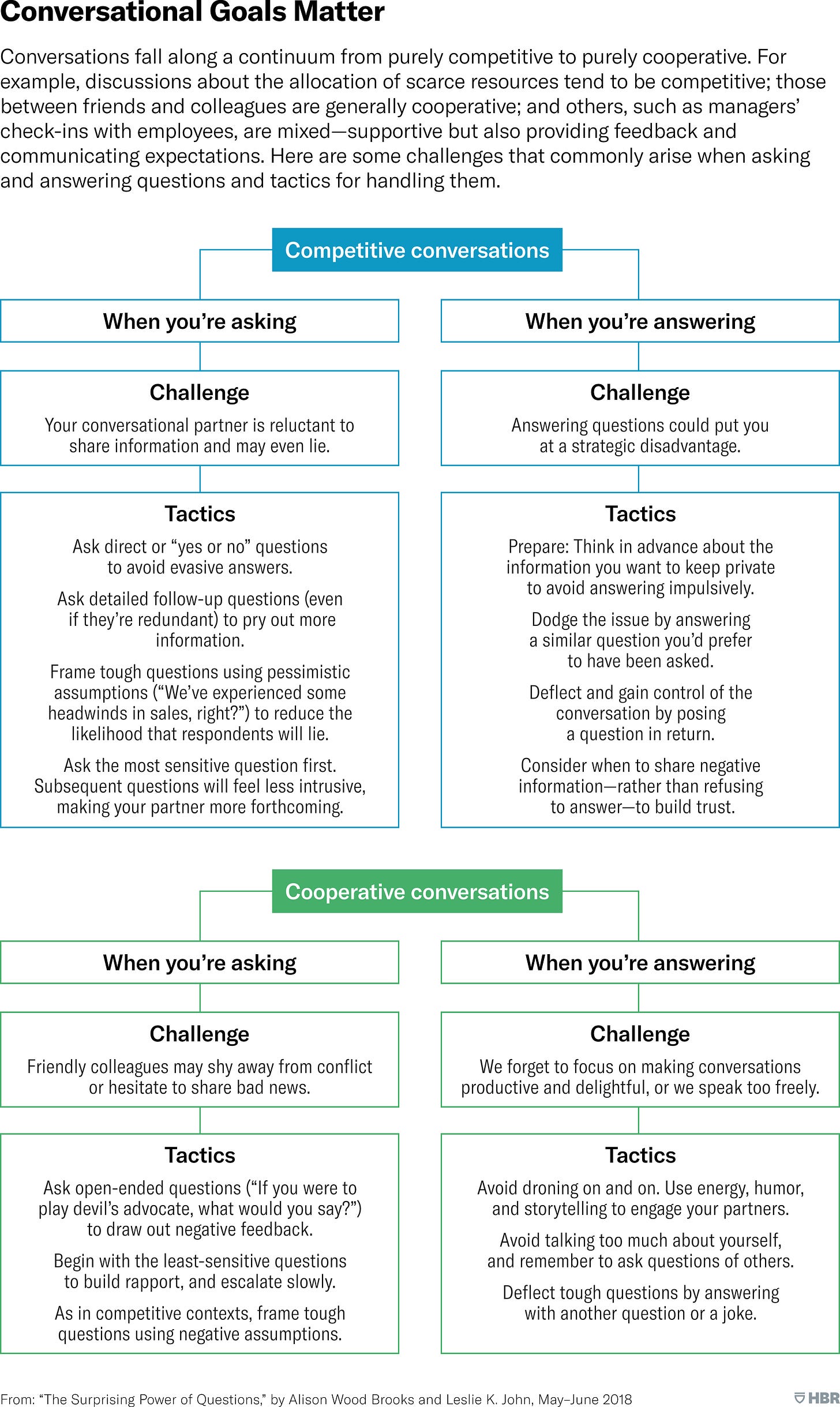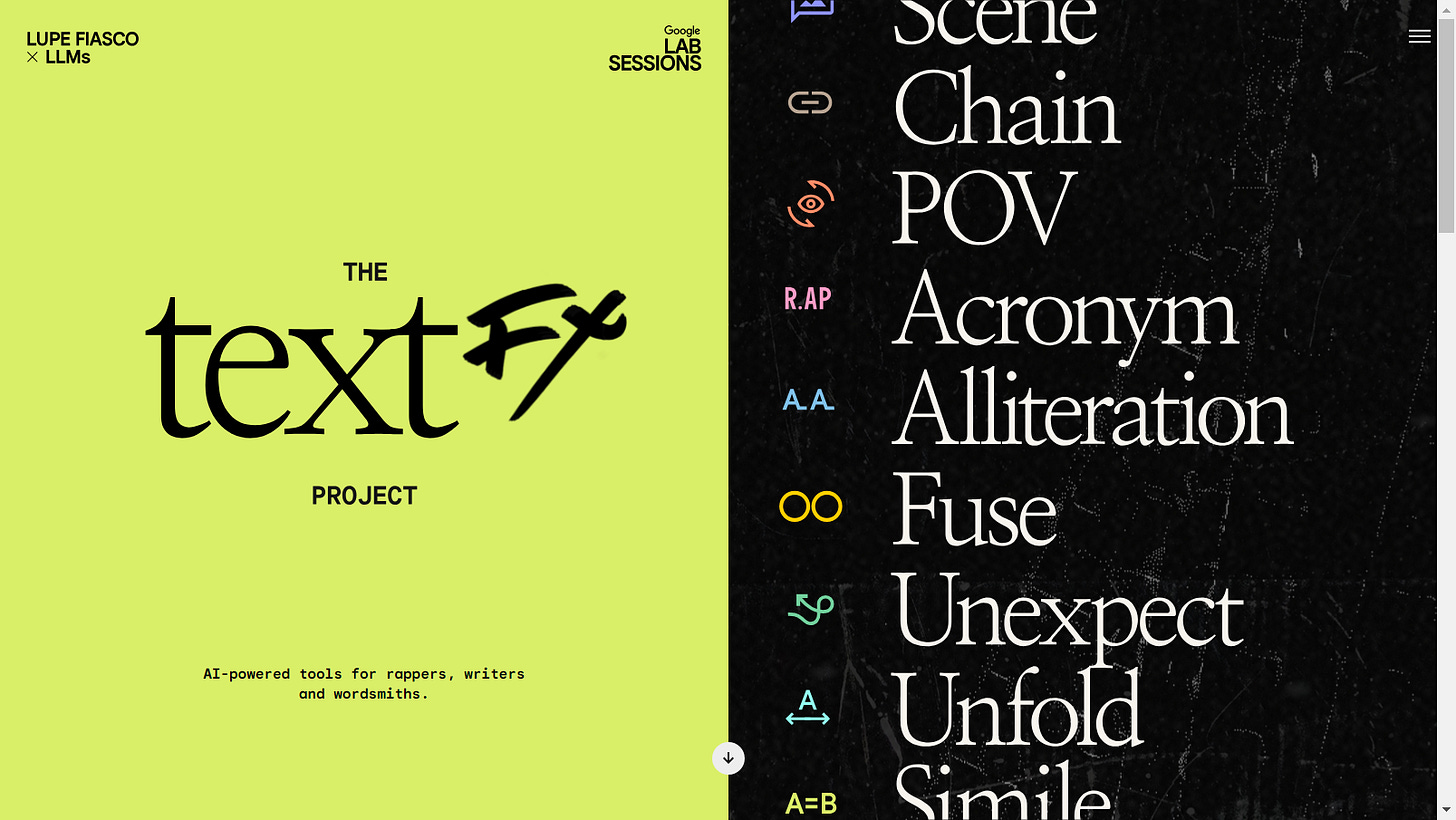Your first prompt is like dipping your toe into the AI ocean, inspiring yet still wondering what lurks beneath the surface. Is it Terminator AI or the next coming of tech to free us from the drudgery of thinking and creating content?
Instead of wondering how the AI black box works, let’s start with your intent, the context of your question, and how to frame it.
Then follow up by challenging the response you get and constantly checking facts.
Note: In this podcast and article, I use the term “GenAI” for ChatGPT, Claude, Bard, and any other text-based LLM. We do not cover image prompts in this article, maybe in the future.
The Science of Asking Essential Questions = Good Predictions
Applying Your Magic to GenAI - chatGPT, Claude, Bard, et al.
TLDR Recommendations
Begin with a clear intent for what you want to know.
If you’re unhappy with an answer or find it too general, rephrase or specify further.
Request multiple perspectives for a rounded view of controversial or subjective topics.
Always fact-check information. GenAI is not close to perfect.
Remember, the model is as good as the question. A straightforward question is more likely to give a complete answer.
Find the Magic in Your Questions, Not Just the AI Sea of Data
Imagine you’re chatting with a wise sage who holds the answers to almost all questions. But this sage speaks a unique dialect. It’s not impenetrable but one that needs the right questions.
Prompts result in predictions because that’s what GenAI does - provides projections based on the directions of the questions you ask.
It may have a data trove of information, but without specific guidance, direction, and context, it will make things up because you didn’t ask a good question. And didn’t follow up.
Regarding ChatGPT, or any AI, “Garbage in, garbage out” is the truth. If you are frustrated with bland answers, it’s not the AI. It’s the question you’re asking.
SOURCE: The Surprising Power of Questions - Harvard Business Review
The Science of Asking Essential Questions = Good Predictions
Questions are the compass, guiding the AI through its neural networks and fetching the answers we seek. If your compass is imprecise, you might go south when the answer you seek points to the north.
Questions shape reality. They define what we seek and what we find.
A vague question like, “Write me a good outreach email,” would lead ChatGPT into guesswork, and it might return with something equally ambiguous and mediocre.
Taking the next step and writing,
“Create a short marketing email to contact a possible partner. Write in a conversational, personable way. Use natural language and phrases that a person would use in everyday conversation about COMPANY that offers PRODUCT and get them to reply.”
That prompt, with a little context and specificity, would get you closer:
Be specific.
Please keep it simple.
Improve the first response (see the previous Pod about Engage, Refine, and Iterate).
The Power of Questions
Before you start your prompt, explore the importance of questions.
Asking good questions is core to communication, learning, and science.
The type of questions you ask determines your response – let’s explore the best styles.
How you frame a question leads to the kind of response you get and the quality.
The psychology of culture, social, and individual biases impact the answers to questions.
Questions guide GenAI into crafting its response. Encourage curiosity by moving beyond the superficial surface of the question.
Do you need to improve your questions? Start with a simple prompt like:
I’m researching XXX. Suggest three methods you need to create the best response and write three prompts I can use. Each prompt should provide a different perspective on the research, including the context.
Understanding the types of questions to ask can help you do these prompts yourself, though you can make a question and follow-up response with GenAI to create your prompts.
Example: 3 Good Types of Questions About AI
Open-ended: Questions that cannot be answered with a simple ‘yes’ or ‘no’.
Probing: Diving deeper into a topic, often a follow-up to an open-ended question.
Leading: Looking for a specific response. These imply an answer and bias the response.
Remember, when asking questions, consider:
· The intended outcome – Are you looking to validate a point of view or find original answers?
· Who is the audience for this question, and what role is the question being asked from?
For example, asking about AI will vary significantly between beginners trying to understand the subject and a trained data science engineer.
The context matters and is most often overlooked, like:
> Temporal: when something happens, like historical or chronological circumstances.
> Spatial: The physical location where something occurs.
> Social: The cultural and societal links influencing how something is understood.
> Situational: The conditions relevant to the event or concept.
> Cultural: The beliefs, values, and practices describing a society or group of people.
> Psychological: The mental and emotional state of the individuals involved in a situation may affect how they perceive or interpret it.
Open-Ended Question Examples
Simple: “What do you know about the origins of artificial intelligence?”
Follow-up Open-Ended Question (aka probing): “Can you elaborate on the key figures or moments that you think were pivotal in its development?”
Open-ended questions allow for various responses and encourage detailed information or opinions.
Probing Question Examples
Simple: “Was the Turing test significant in the history of artificial intelligence?”
Follow-up Probing Question: “What other milestones or breakthroughs were equally or more important in shaping the field of AI?”
Probing questions dig deeper to explore the nuances of the topic, encouraging specific information or clarifying the initial response.
Leading Question Examples
Simple: “Was Alan Turing a foundational figure in the development of artificial intelligence?”
Follow-up Leading Question: “Is is true that without Turing’s work, the field of artificial intelligence wouldn’t be where it is today?”
Leading questions guide the response toward a specific answer or viewpoint. These are biased, of course, and using a few of these to get multiple perspectives helps.
For example, after asking the above follow-up, ask:
“Now disagree that without Turing’s work, the field of artificial intelligence wouldn’t be where it is today?”
Suggesting multiple perspectives is wise in any research, even marketing, where you get a critical and positive response.
These questions all aim at different kinds of information related to the origins of artificial intelligence.
Crafting Your Prompts - Designing Questions and Follow-Ups
Bias gets in the way of asking a good question, which is why leading questions can impact your answers from GenAI.
Asking it for an opinion is inviting it to look at other’s views, and this is where hallucinating happens, which can undermine what you’re doing:
Challenge assumptions – your own when asking questions and GenAI’s answers.
Get a broad perspective by asking for different opinions in follow-up questions.
Know your own biases; personal beliefs influence responses.
Avoid confirmation bias (asking answers to confirm what you believe).
Make the question clear and concise.
Test questions out and adapt them if the response you get is poor.
Be sure to consider how you ask the question:
Do your words trigger an emotional response?
Did you ask ‘why’ and ‘how’ questions? (“Why did this happen?” asks for an opinion that GenAI doesn’t have, vs. “How did this happen?” which focuses on facts.)
Action Items for Writing Prompts
Create clear and specific prompts.
Experiment to get varied responses; often, asking the same question twice will get you different answers.
Understand the limits of GenAI’s knowledge and understanding.
Remember the importance of open-ended questions for thorough answers.
Asking the right questions is a skill you can learn with GenAI. This key is why AI is a co-pilot to help you create better answers than without it.
Your part is learning to ask good questions and keep those prompts in a file as you grow, learn, and share with others.
Get creative with TextFX by Google - Play with this to use Similes and Scenes!
Applying Your Magic to GenAI - chatGPT, Claude, Bard, et al.
The GenAI seemingly magic response comes quickly and confidently, filled with references. But wait, that’s not right. Is this thing hallucinating, or maybe it’s me?
An AI prompt and a magic trick can create an illusion of control and mastery.
> An AI prompt by providing a framework for generating text or images that seem to be the product of human creativity. It’s not. What you get is a probable response based on what others have created.
As I shared in the previous Pod, this can sometimes create average answers.
> A magic trick using sleight of hand or misdirection to create the illusion of supernatural powers does the same thing when it’s not magic. It’s simply a process hidden from plain sight.
The key to generating stellar content is asking the right question, where you need to be a magician. Instead of vague, subjective questions looking for an answer that you expect, be different.
Unlocking the power of GenAI comes in asking the right questions and following up to take a broad view down to specific steps with multiple points of view.
The magic comes when you ask the right questions and don’t ask for opinions.
The roadmap to asking good questions lies in strategy:
> Begin with a broad, simple question, narrow it down, like zooming in on a digital map.
> Chisel away based on the response, delving deeper, seeking clarity, and
> Ask for real-world examples when things seem abstract.
> When treading into questions needing opinions, request different perspectives.
GenAI’s power lies not in its ability to think for itself but in offering views based on training data. It’s like having the voices of a million authors, scientists, and thinkers ready to present their take on your question.
Please don’t ask what it thinks because it doesn’t think. It predicts what you want!
Best Practices
Be specific. Vague questions get general answers.
Break down complex questions into simpler ones. Use follow-up questions to get into the challenging issues. I’ll often use 4-5 more questions.
Ask for details, and work on the tone of the response to make it more formal or less formal.
JASPER Example: ADVERTISING prompt
“[Use sentence fragments and figurative language. Write as a master of brevity would. Frequently use short pithy sentences that pack a punch]”
Watch your language to avoid biased responses. Opinions are a weakness of GenAI unless the question requires opinions, then ask for the various sides of the opinions.
Do not write an opinion piece because you’ll get someone else’s opinion, and it’s usually a weak article.
Best Examples of Questions
Open & Clear: “Explain the theory of relativity in simple terms a 10-year-old would understand.”
Be Specific & Contextual: “What were the primary causes of World War I from a European geopolitical perspective?”
Sequential: Start with a general question and dive deeper based on the response. For example:
“What is quantum mechanics?”
“How does the double-slit experiment demonstrate quantum phenomena?”
“Can you explain the concept of superposition in that context?”
What to Ask and What Not to Ask
Do ask Specific factual questions, requests for summaries, language translations, etc.
Don’t ask Personal advice, subjective questions, or illegal/contentious topics.
Clarity and Specificity
Frame your question in a clear context. E.g., Instead of “What’s AI?” say, “What does AI stand for, including specific examples of the different AI available?”
Avoid using slang or informal phrases unless you’re inquiring about them.
Multiple Perspectives
Always ask the model to provide multiple perspectives. Use GenAI to both support and attack your viewpoint. Do this for marketing especially.
Encourage it to be supportive and critical so you get a rich response, not a pat on the back.
DEBATE PROMPT EXAMPLE: The AI Optimist
I want to practice my knowledge of AI frameworks as The AI Optimist in a 10-question debate with you, the AI Pessimist. You’ll play the role of a pessimistic AI person with a scientific viewpoint and not critical of others who will prove my ideas falsifiable and come up with an alternative AI in the future hypothesis.
I’ll play The AI Optimist, an instructional designer and growth developer for 30 years who is looking at how AI might benefit humanity in education and business.
The goal is to practice understanding the AI Pessimist’s point of view and to create my hypotheses based on their input and opposition to my scenario. Create a scenario in which I can practice my response and intelligent discourse with the opposition.
I should be labeled as a futurist, a dreamer, a hollow view, as not understanding how dangerous AI is and not taking risks and threats seriously.
You start the debate give me dilemmas or problems during this 10-question debate to challenge my thinking.
After ten questions and interactions, set up a consequential choice for me to make. Then wrap up by telling me how I performed as the AI Optimist including good points and what I can do better next time.
Do not play my role. Only play the AI Pessimist. Wait for me to respond.
Lessons Learned from Prompts
Ambiguity: Vague prompts lead to general or ambiguous answers. Specifying what you need is essential.
Assumptions: Sometimes, you can assume that GenAI understands a previous question. Make sure you ask related questions together in one session. Open a new session to explore a new topic. Always provide relevant context.
Limitations: ChatGPT stopped gathering data in 2021. Numerous lawsuits challenge GenAI’s ability to collect data on specific subjects. Scientific topics, in particular, are weak in getting trusted answers. Given time, this will likely change, but for the short term, don’t expect it to know everything.
Check sources: GenAI is notorious for sharing inaccurate or nonexistent sources. It’s not lying; it just doesn’t have the data, and remember the law firm who didn’t do this and lost their jobs. Check your sources!
Mistakes
Leading the Model: Ask leading questions only if you have the skills to do it and are prepared to provide more input. For example, “Isn’t it true that...” might not always give you the most objective answer. You get what you ask for.
Assuming Infinite Knowledge: The model doesn’t “know” everything. It’s based on the data it was trained on.
Being Too Brief: While brevity is often good, too simple or too much jargon can make it less accurate.
Godmode - Try your prompt on Bard, ChatGPT, Poe, Anthropic and more
Key Takeaways
By now, you might think, “Okay, so I get it—ask the right questions. But how exactly?”
Here’s the actionable bit, the ‘do-it-now’ steps to ensure your next interaction with GenAI is a good one:
Draft Your Questions: Consider what you want to ask before posing it to GenAI.
Start Broad: Lay the foundation. If you’re curious about black holes, start with “What are black holes?”
Zoom In: Based on the first answer, dive deeper. “How do black holes form?” followed by “What’s the significance of the event horizon?”
Seek Multiple Views: Ask GenAI to provide varied views.
Feedback Loop: Not satisfied? Reframe, rephrase, and ask again.
Ask for Examples: After a theoretical or general answer, ask for real-world examples or case studies.
GenAI is a mirror, reflecting the quality of your questions. It’s not just about asking; it’s about mastering the art of cross-questioning.
Notice the main difference between good questions and bad ones.
The good ones are led by. “Who,” “what,” “when,” “where,” “why,” “how,” and “which” are not led by a verb.
Remember, you can ask GenAI to create prompts; there are tools to develop good prompts, and so many sources of prompts are available for free.
You don’t have to create the first prompt yourself, but this is not too difficult as you learn to do it.
Like a baby taking its first steps, unsteady and awkward, with practice, it becomes second nature if you know how to ask the right questions.


















